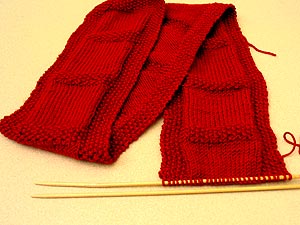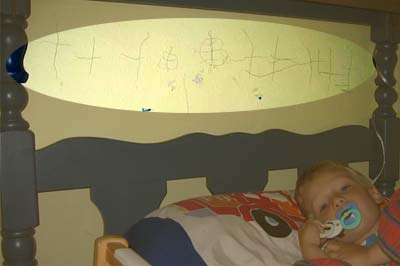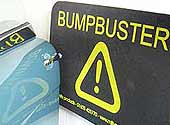The Rest of the Story
She called again at 11 p.m. from the hospital to say she was being admitted. She was 2 cm. dilated, but contracting regularly every 6-7 minutes. They didn't want me to come yet. We left it that they would call when they were ready.
Her partner called at 2 a.m. to say they were ready for some support. I arrived to find the mother on the birth ball, contracting every 3-4 minutes for about 30 seconds each time. She was serious, vocalizing with the contractions, and talking little in between. In short, she was laboring well and actively.
This couple was very committed to a natural birth for this, their first child. When the mother expressed some frustration on the ball, I suggested the tub as a change of pace. She liked that idea. After having several contractions on the toilet, she got in the tub where she relaxed completely. Her reactions to her contractions changed. She was more vocal and expressed more doubt. She prayed for strength and mercy (my words not hers).
After the tub, we went back to the bed. She knelt on the bed and leaned over the back of it. It was the wee hours of the morning. She was tired. Because she was so relaxed between contractions, it was hard to tell if she was dozing or not.
She was 4 cm. by 4 or 5 a.m. She had asked not to be told her "progress." Instead we said what great work she was doing, assured her that she was making progress and proceeded with laboring. She spent much of her time on the ball, leaning onto the bed. Some contractions she leaned backward into her partner, who was on a stool behind her. She remained extremely limp and relaxed in between contractions. At one point, she was slung back into her partner's arms, her head lolling off to the side and her arms draped wide to either side. She looked more like someone passed out at a college party than a laboring mother -- all the more ironic because this woman is extremely religious and substance avoiding!
Her mother arrived around 6 a.m. What a boon. This was a woman who believes in natural birth and did nothing but encourage her daughter. We all should be so lucky. Her presence energized the room. The laboring mother was working extremely hard at this point. She was non-verbal. She got shakey and had some contractions on the toilet that she grunted through. A check showed that she was 7 cm. dilated and had moved the baby from -3 to -1.
Shortly after that exam the baby's heart-rate lowered to the 100s and the 100-teens. After several position changes, it settled in the high teens with the mom on her side. For a while they were giving the mother oxygen, but it didn't make a difference in the heart rate, so theys topped. They also started IV fluids because the mother was very dehydrated despite our pushing fluids by mouth.
She began to have very bad back labor (my arm is only starting to get sore as I write!) and we entered a time of constant pressure on her back, as well as constant encouragement and acknowledgement of her hard work. She doubted our assurances that it would not last forever. She began talking about feeling pressure, so they checked again.
It had been nearly 3 hours since the last check. Nothing had changed. Ah, plateaus. We all know they happen but they are so hard to face when you've been up all night, when labor is so hard, when you want to be done.
Thankfully the mother was still in the dark about dilation, station, etc., so we continued as we had been. Because of the heart rate, no one suggested moving the mother off her side. Also, she rested deeply in between contractions, so side-lying seemed a good position.
With her water broken, doctors were getting itchy to see progress. They checked her again afternoon. She was still at 7 centimeters, though the baby was now at zero station. She had been in transition-strength labor for more than six hours and no change. The doctors continued to be concerned about the heart rate. It was occasionally dropping below 100 according to the monitors, though it was hard to tell if it was the baby's heart or the mother's they were picking up. The doctors suggested putting an internal monitor on the baby and a pressure catheter into the mother's uterus.
I was getting very discouraged, as well as foggy from my short sleep. I put in a call to T$ to see if she could relieve me. Though I definitely have thought (fantasized?) about it before, this was the first time I'd actually called in my backup. Except the backup couldn't come. She had about one free hour, but then preexisting commitments at home and a spouse who was out of town meant she'd need to leave again. I thought about my options. I could dash home and try to catch an hour's nap. The chances of that were slim -- it's always hard for me to fall asleep after the charged birth atmosphere. I could call in another backup. But my clients only knew T$ and I didn't have anyone else even alerted to my birth schedule. I could stick it out. That was the only realy option.
T$ offered to come once her spouse got home. We left it that I'd call her at that point if I needed to. Before she hung up she said, "Make her change position. Get her out of bed." T$ is the person I look to for an example of how to assert oneself as a doula when you need to. I tend to be more submissive to the mother's needs. I wince at the thought of making a mother move when she has found a comfortable position...even if she's been in it for four hours! T$'s certainty filled me. I hung up, went to the bed, and said, "You're not going to like me, but you've got to get up."
The mood in the room changed. The mother was right on board: "That's right. We've got to get you in a different position." The partner got a second wind. He talked with the doctor and they agreed to use more frequent cervical checks to monitor the contractions' work rather than a pressure reading. The couple declined the internal monitor, after requesting to have their doctr, rather than the resident, come talk with them. Their doctor was fine with that decision.
We gave a few choices and the mother picked the ball. The baby's heart rate actually improved when the mother got upright. After some time, she went in the tub again, on all fours, and found some relief. She got out and labored in bed a while, but became insistant about feeling pressure. Another exam found she was 8-9 centimeters. She avoided the pressure catheter and pitocin and dilated all on her own.
Another hour later she was a stretchy 9 centimeters. She pushed for a few contractions to see if the baby's head would slip past the cervix. It wouldn't. She had a strong urge to push at this point and I raspberried through contractions with her to try to keep her air coming out instead of being held in to bear down.
It was another two hours -- and one or two disappointing checks -- before the mother was complete. By that time, she'd labored the baby down to zero station. We cried, hugged, high fived. They prayed and thanked God. Then pushing stared.
With the mother's first push the heart rate fell to the low 100's. The mother felt constant pain and pressure and was pushing without taking breaks. She was following internal urges completely. The nurse called out "80s" and they turned the mother on her side. The heart rate went up again into the low 100s. The mother took a bit of a breather but then was right back pushing. The heart rate fell again. They put on an internal monitor that pinged like a second-hand. The heart rate was in the high 50s. Suddenly there were about 8 more people in the room. The mother was still yelling and pushing and obviously in anguish. Nurses were talking with doctors were talking with other doctors all deciding what to do. The heart rate came into the 90s. One nurse said, "I am not comfortable being in this room [versus the operating room] right now."
Pretty quickly they decided to take the mother back to the operating room. Unplug, unlock, and away they went with four anxious family members, a doula, and a photographer in tow.
We stood outside the double doors to the operating bays for ten or so anxious minutes. Then someone -- no nurse or doctor we'd seen before -- came out and said the heart rate was up again and that one person could come back with the mother while she pushed. She was going to have to deliver in the OR in case they needed to do emergency surgery. So the partner suited up and went in, taking the photographer's camera with him.
I'm not proud to say it, but I went home at that point. I was not going to be able to help with the birth. Establishing breastfeeding was the next big step, but I did not have it in me to wait until things settled down after delivery so I could help. Not to mention, the hospital they were at has a special team of in-house breastfeeding support nurses who repeatedly visit every mother that plans to breastfeed. I conveyed my regrets to the remaining family, who were very understanding.
When I went to bed last night I still hadn't heard anything. All night I had intense, over-tired dreams of going to visit the family and learning their baby was in the NICU. Or of being at the birth and seeing a silent baby being intubated.
Thankfully this morning the partner called me at work. He said a healthy baby boy was born around 8:00 last night with assistance from the vacuum extractor. Guess what? He was born face up. Yes. A posterior baby.
If this blog were a film, you would now see a montage of scenes:
--the doctor doing and exam and mouthing "no change"
--the mother arching and wailing "Oh, my back"
--the mother on her hands and knees in the tub THEN the the doctor announcing dilation change
--the heart rate tracing showing paired contractions
then me with the word "clueless" overprinted. How could posterior baby not have crossed my mind? I'm not saying we could have flipped him. And she did spend time leaning forward, whether on the ball or over the back of the bed. But I like to think if we'd known, we could have rolled him around and made things go better. On the other hand, we might have only moved him half way... and that could have been worse.
Labels: birth story, doula








 The Little Red Hen had iconic status in my house as a child. My mother did not read aloud to us often, but I can clearly hear her voice reciting the hen's litany of requests: "Who will help me plant the wheat?" "Who will help me grind the flour?" "Who will help me bake the bread?"
The Little Red Hen had iconic status in my house as a child. My mother did not read aloud to us often, but I can clearly hear her voice reciting the hen's litany of requests: "Who will help me plant the wheat?" "Who will help me grind the flour?" "Who will help me bake the bread?"





